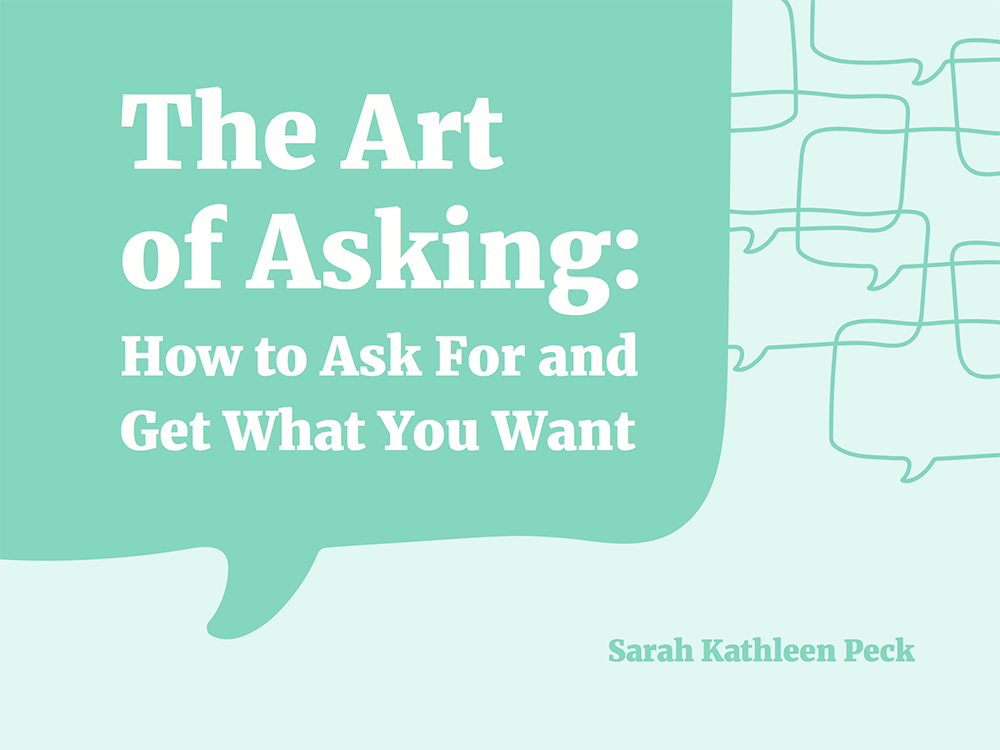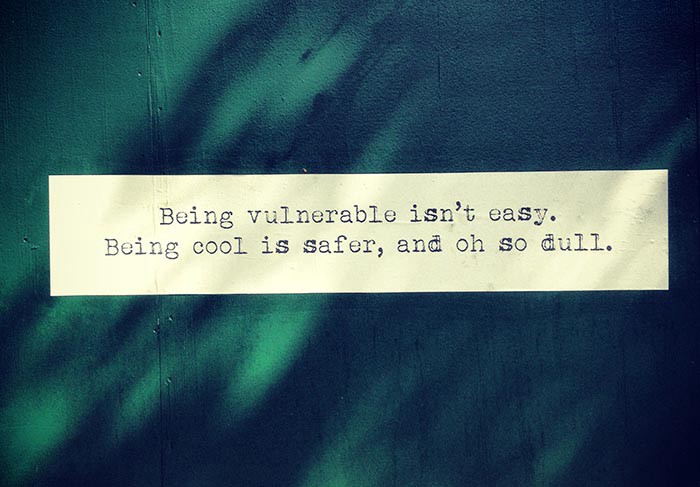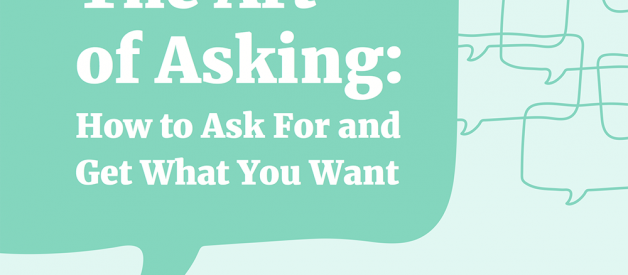If you don?t ask, the answer is already no.
Note: After publishing this essay in 2013, I was startled by the response that it got ? it?s been recommended more than 500 times, re-published in some of the biggest Medium publications, and recommended to product teams at some of the biggest design firms in the world. It?s now available as a free guidebook for you to use in your own work and practice. Grab a copy of the workbook by clicking the image below or going to https://www.sarahkpeck.com/ask/ to get the free e-book. Look forward to your thoughts and reflections on the essay.

What does it take to ask for what you want?and then get it? There seems to be a magical art behind creating a great ask, and we all know stories of people who seem to get exactly what they want whenever they ask. Magicians who bend and will the world to their ways. Why is this? What are they doing that no one else seems to be doing? How do they ask for what they want and seem to get it every time?
Culturally, it?s not always the norm to ask directly for what you want?or we do a terrible job of it (and women face significantly more challenges in both cultural norms and consequences for making direct asks; see HBR and NYT for more). Instead of specifying what we want, we hem and haw about ideas, often walking away from great conversations without clearly articulating our message, what we hope to achieve, and how the other person can directly help us.
Creating a great ask (and learning the ability to say no) are two skills that successful people learn how to do really well. When you ask well, you can get what you want more quickly?saving you time and energy. In the past decade, some of the things I?ve asked for and negotiated for include: asking for multiple raises and getting them consistently, negotiating salary bumps of 20% or more (with credit to Ramit Sethi?s persuasion tactics), winning over $50,000 in scholarships (competitions and essays were involved), and recently raising $33,000 for charity: water by promising to swim naked from Alcatraz to San Francisco if we raised enough money.
In addition, I?ve helped clients understand persuasion tactics and develop scripts to ask for what they want, including the delicate art of deciding to do it anyways and asking for forgiveness rather than permission. Several people asked me to collect my notes on how to ask and share them publicly. Here are my top tips for creating a great ask?in order to get more of what you want.

The art of asking for what you want,Part 1: You have to actually ask.
1. First, know what you want. This is an all-too-obvious step that?s often overlooked. Often it?s not always clear to you (or others) what it is, exactly, that you?re in need of. The more clarity you can have about what you want, the better. Take the time to learn, figure out, or discover exactly what you want. Once you know what you want ($1M in funding, a date with a lady, a new bookshelf, a corner grocery store), it?s easier to ask for it.
2. Ground yourself in why you?re doing what you?re doing. Start from the heart center: before I ask others to join or respond, I check in with myself, asking with my heart and mind and body, making sure this is what I want and that it resonates with who I am and what I stand for.
Is this something that I want to do, and want to do deeply? Is this something I stand for and believe in?
If you don?t want it at the center of your core, ask yourself why you?re going after it. If you do want it, ask yourself what you?d be willing to do for this. Much of my work is contingent on confidence and alignment with the programs I?m creating. If and when I draft an email that doesn?t ?feel right? or my intuition tells me is coming from a place of loneliness, desperation, or need?I pause on the email and draft it a few other ways.When I circle back and remember why I?m doing what I?m doing, the words come more easily.
Amanda Palmer, in the highly watched (and just as readily criticized) TED talk, speaks of the vulnerability that is required in asking for what you want. To ask for something is human; to want something and ask someone else for it requires a connection.
?Through the very act of asking people, I connected with them. And when you connect with them, people want to help you. It?s kind of counterintuitive for a lot of artists ? they don?t want to ask for things. It?s not easy to ask. ? Asking makes you vulnerable.?
? Amanda Palmer, The Art of Asking
 Creating a great ask is about making connections between people and things?and often requires vulnerability.
Creating a great ask is about making connections between people and things?and often requires vulnerability.
3. You have to actually ASK for what you want. It sounds so simple to write this, and almost insanely easy advice. But there are too many people who do not ask for what they want. They?ll tell you a story, email you to say hello, spend hours talking in circles about their idea, hedge and hum about a faint aspect of their idea?and somehow hope amongst all the befuddlement that somehow the other person they are talking to will be able figure out what is is you want and help you solve your problem. You need to put it out there.
In order to get what you want, you have to ask for it.
4. Be direct, clear, and specific about what you want. Make it ridiculously clear what you?re asking for. Be direct about what you want, who it?s from, and when you need it, and what a desired outcome looks like. The more specific and direct you can be, the better.
- Define the problem. What are you trying to solve?
- Specify what it is, exactly, that you want. What materials, processes, steps, pieces, or people are involved to solve it? Is this made abundantly clear?and easier to read than an IKEA assembly manual?
- Outline how much time, energy, money, or commitment you think it will take. Be clear about what the person will have to do to fulfill the request. If it?s a sale, specify when, where, and how they can get what you?re asking them to buy. There?s nothing like deciding you want something and realizing that the person who invited you didn?t put a ?buy here? button on their website.
- Be direct. Put the ask up front and early, and again in the close of the message.
5. Be selective and targeted about who you ask. The more specific you can be about WHO you ask, the better. Asking everyone in your network is bound to get you a bunch of silence in our over-connected world, or active unsubscribes and un-follows across your various platforms. It?s better to ask three people who are very well equipped to answer your query than 15 people who aren?t interested at all.
Do not send your email to your entire contact list. People in Boulder have no interest in the program you?re teaching in San Francisco (unless, perhaps, it?s a digital class). The more specific you can get about WHO should be receiving the message, the better. One direct ask that results in a yes is better than asking fifty people who don?t respond (and spamming their inboxes).
This can be far more work than it sounds. When I craft campaign emails and fundraising emails, I?ll sit and pour through my contact database and customize a list of 20, 80, 100, 200, or 300 people that I think would actually be interested in my project and that I feel comfortable emailing. Sometimes I goof and send people too many messages, but thankfully most of my friends and colleagues have been forgiving and kind about the messages I?ve sent (and say no when they want to). I?ll craft 10 different versions of emails to go to small sub-groups of twenty people, each group carefully constructed based on who knows who; what the question is; what the story lead is; and how I?m framing the ask.
6. Use social proof by creating micro-groups and mini-masterminds. When you email a small enough group, the presence of one initial response often prompts others to respond as well?creating the inertia of ongoing conversation rather than having to circle back and bother more people. When I email a group of five people that I highly respect and ask them to join a conversation, I try to include someone that I know is great at responding quickly. This generates an ongoing conversation.
When the group is small enough, the conversation becomes private and personal enough that it?s like a micro-mastermind group with content rich enough to be worth thousands of dollars. Sometimes after an day on a message thread, people have written back to me privately and said, ?this advice is worth gold?thank you so much for including me in this group. I learned so much!?
An example that stitches these all together:
A while ago I ran into a problem with a particular type of client that I was having trouble closing?and instead I ended up spending weeks in back-and-forth emails continuing to describe the product instead of making the sale (and ideally directing my correspondent to a solution to his problem). I couldn?t figure out if this was a dead-end lead, or if my writing was generating the excessive conversations.
I thought?why don?t I ask a few of my successful business friends for advice?
I thought closely about who might be a good person to answer the question, directed an email at three people, copied each of them on a single email, and wrote the following request:
A sample script for asking a mini-team of experts for help with a problem:
Dear John, Susie, and Rob:
I hope you?re well. I?m having a pinch point in my client pipeline and I?m looking for some feedback?and I think you?re the perfect person to help me out because I?m pretty sure you?re a pro at dealing with this type of client request in your business.
This email will probably take you about 10-15 minutes to read and respond,and I?d be incredibly grateful for your straight-up advice. I?m predicting that you know exactly how to deal with this problem, which is why I?m contacting each of you.
If any of you are swamped today or in the middle of something that needs your attention, feel free to delete this email or send a quick ?so sorry, can?t,? so I know not to bother you again. Ideally, you?ll know a great resource (a book or link) that answers this problem and can think through this quickly with me. Many thanks for your brilliance in advance.
Here?s the situation: ? I?d like to come up with a great response that changes the answer I?m getting (below) into an answer that converts into a sale. This email chain below is a typical one for me ? (and here you continue to describe the email you get and copy, exactly, the messages you get and the emails you?ve sent previously.)
In summary: when I ask people for help, I select one or a few targeted people to reach out to, I define the problem, outline what I?d like them to help me with or what I?d like them to do for me, and tell them how much time I think it should take, and I give them enough information to make it easy to answer. As a courtesy, I also like to let folks opt-out if they?re in a busy point in their lives.
 How many times should you ask? Who should you ask? Are you repeating yourself?
How many times should you ask? Who should you ask? Are you repeating yourself?
Part Two: How many times should you ask?
7. Make sure you ask in multiple ways and in multiple places?show up across multiple platforms customized for different individuals. Every time I launch a program, offering, or class, I make sure to send my ?ask? into the universe in a number of different ways.
It?s not enough to create something and wait for people to show up. Both before and after you make your product or offering, you need to invite people to come take a look, to review it, to purchase it, and to see what you have to share. Without asking people to buy your product, it?s like walking into an empty room, filling a keg with beer, and not telling anyone you?ve got beer behind those brick walls. Unless you put a sign on the door, distribute flyers in all the neighborhood mailboxes, and put a sign out front with free beer coupons for the first 100 customers, no one will know that there?s a keg full of delicious goods inside of that brick house.
You need to show up where the people who have what you want are already playing, paying, or talking.
?It?s not enough to create something and wait for people to show up. You need to tell them about it.? (Tweet this!)
Put your offering or request in several (targeted) places. Show up in person, on email, in newsletters, on twitter, on Facebook, and in any other place where people who want what you have?or can give you what you want?already spend time. Further, you?ve got to ask in a number of different ways.
Next, send personalized requests or invitations on a 1:1 basis to people you think would be great early adopters, fans, or supporters. Tell people what you?ve been up to. Start with your own network, no matter how big or small, and ask them to come show up. An email to ten friends and family members asking for support is more meaningful initially than spamming your entire Facebook friend list and showing that you?ve invited 500 people and only 2 of them RSVP?ed.
8. Ask multiple times. Do not be afraid to ask someone more than once for something.
Sometimes I get nervous that I?m repeating myself. Remember that what you hear is not what they hear. The last time that I got nervous that I was talking incessantly about my project for charity: water, I started to get sick of my own voice and assumed everyone else was tired of hearing about the project, too. In reality, you?re only talking to each person once or twice, even though you yourself have had the same conversation hundreds of times. Keep going and remember that each time you ask, the person on the other end may be hearing you for the first or second time only? and every time you ask, you increase your chances of getting what you want.
Additionally, people generally need to see your ideas 4-7 times before they really familiarize themselves with it. Multiple messages are okay. If you send one email and no one responds, you might need to send another message in two weeks? time, after people have had a chance to see it and hear about it. Just because you are talking about it all the time does not mean that the other person hears or sees everything you?re saying.
It?s okay to ask more than once. I imagine that some folks are scrolling their iPhones while on the toilet, reading in line, and not always ready to act or do something at the moment and place where they receive your message. In a mobile world, people are getting messages while they are already busy?out shopping, eating, running errands, or at work. They want to donate or buy, but forget. Following up with a second ask is certainly fine.
And if you create a great story?and you sweep people up in your project, they will rally behind you and want to know how the campaign is doing, and they want to know when you win. People love a good story. The additional messages aren?t a nuisance if they?re well-crafted?they?re bringing people into the story and along for the ride. Share your enthusiasm with them.
9. Try asking EVERYONE. Push yourself beyond your comfort zone and strike up conversations with strangers. Talk to your taxi cab driver, your bus driver, your school teacher, your yoga instructor. Tell your story like it?s the only story you have. (Note: this differs from targeted asks, above, because you?re not sending a blanket email to everyone that?s non-specific. This time, every person you meet should be someone you can talk to about your project and process, and each person should get a targeted message or a variant of a custom message).
When I was on a mission to raise money for charity: water, I asked my bus driver, my taxi driver, the brunch group, people at my swim, the coffee barista, and every friend I knew to participate. I ended up having one of my Lyft drivers laughing so hard that he gave me cash straight out and volunteered to graffiti-paint my body for the swim.
You. Must. Ask. Everyone.
10. Practice over and over and over again. Every small ask is practicing for a bigger ask. Each email and correspondence is an opportunity to practice. In college, my swim coach set us out on missions to experiment with our psychological edges?and in one experiment, we had to ask for a free lunch. It was awkward. Many people said no. And some people said yes. Each time, we practice asking for unusual things.Ask until you get a yes answer. Learn from each iteration.
11. Follow up. Ask. Do what you say you?re going to do. Say thank you. If you want to stand out, ask for what you want, follow up, and follow through.Most people don?t do this.
Part Three: The psychology of decision making, why touch matters, and considering context.
12. Be audacious. Much like Jia Jiang?s experiment with hundreds of rejections (where he set out to get used to the idea of rejection by asking for ridiculous things), he found that the more he asked, the easier it got to ask for what he wanted. As a bonus? People said yes. He ended up driving a police car, flying a helicopter, and dozens of other crazy adventures simply because he walked up to people and had the audacity to ask.
13. Keep it simple. Put the ask on the table. Make it easy to find. Make your wishes known.
- Give alternatives if you?d like, but stick to two, maximum three. Sometimes it?s easier for people to say yes to one of two options rather than having to choose between many. Stick to just one or two things.
- Start with small wins.Ask incrementally for specific, small things. Get a foot in the door. Don?t ask for the big thing until you?ve established rapport, responsibility and demonstrated follow-through with someone.
14. Pay attention to context and surrounding cues. People make decisions based on their physical surroundings?much more than they would probably believe. Of all the senses, touch is one of the most important contextual cues. Researchers think this is because we develop our sense of touch first, as infants. According to The Economist, on decision-making, ?research shows that our choices can depend on whether we are holding something heavy or light,? and ?it seems our minds take many physical metaphors (such as heavy or light, soft or hard) literally.? Bring someone a warm beverage and have them sit on a hard chair, and see what happens with your negotiation or ask.
15. Ask at the right time: understand how (and when) people make decisions. If you are asking for something complicated and difficult, ask before the well of will-power is depleted. People grow weary of making decisions throughout a days? time, and make better choices (or are willing to decide at all) in the morning, or when they are fresh (see more on decision fatigue in Psychology Today). In the evening, you?re more likely to get a ?no? as a response if the person you?re asking is tired and worn out from a long day.
16. Be confident in how you ask. Make a statement, hone your pitch, and then put a clear request in at the end.
If it?s a verbal ask, don?t let your voice trail off at the end. Practice body and vocal confidence by standing tall, shoulders back, and with your head up in a controlled, confident stance. If you don?t feel confident about what you?re asking, chances are you need to check in and make sure that you believe in your product or offering, and you need more practice.
This is a great time to fake it until you make it.
17. Master the Pause. When you ask, look the the other person in the eye. And?this is the most important part?then stay quiet. Ask, simply, and then wait. Don?t throw a bunch of garbage words into the space between your ask and the person?s response. The waiting part?that silence?is deafening, but critical.
Give people space to consider what you said and respond thoughtfully before jumping in to fill the silent space with more words. Make a simple ask, and wait. Let them make the next move. Much like kissing a guy (or gal) for the first time, the sweet spot is in the pause and the time where the two parties consider each other.
If you speak up too quickly, you can push them into a space of no.
Body language is critical for this step. Assume a positive stance (feet hip-distance apart, casual, standing still);and put your hands in a neutral position (by your sides or with both hands touching in front of you, loosely). Keep your chin up and your heart space open. Smile confidently and look them in the eye.
Too many people shoot themselves in the foot by asking for what they want and then immediately layering in a couched response that assumes the person on the other side doesn?t want what you?re offering.
Assume that the person you?re asking would be delighted to help you, has exactly what you need or wants precisely what you?re offering, and that they?ve just been waiting for you to ask them.
Surprisingly, I?ve had multiple encounters where people write (or say) in response, ?Sure! That sounds great?I?ve actually been looking for a writing workshop, thanks for thinking of me,? or ?Absolutely, I?d love to help?I know just the right person, want me to set up an introduction??
Yes, yes I would.
It?s surprising how much we don?t get when we don?t give people the opportunity to help.
An ask is a connection. It?s not about having another person go to great lengths for you. It?s about creating a scenario where someone who wants to give can match with what you want.
?Asking is about connection. Create a space where people can give and you can receive (and vice versa).? (Tweet this!)
Part Four: Avoid terrible asks, be kind, and make sure you say thank you.
18. Avoid terrible, generic, vague asks.
I say no to many of the requests for coffee and lunch dates that come my way?although not always?largely when I?m not sure if I can be useful or if I already know that I need to dedicate that limited time to my existing projects and processes.
The worst type of ask is when someone says ?I?d love to pick your brain and get your (generic) advice?do you have time to have dinner or get together one day??
This is non-specific, non-limited, non-structured, and I?m not sure what I can help with or how I can be useful. Chances are that I?ve already answered some of the basic questions in one of the hundreds of essays I?ve written before, or that I can recommend a book or a process that can be helpful and easily sent over in a minute?if I knew the nature of their problem. Lastly, I want to know why it is that I, specifically, am useful?what is it about me that can help you more than anyone else?
When I get these emails, my reaction is to run and hide and shout, NO, NO, NO!
Luckily, I don?t say that. Instead, I write back and ask for a bit of clarification. It?s never a problem to ask people to do a bit more work before you help them. Here are two great scripts for saying no?and helping someone focus their ask:
A sample script for saying no to nonspecific requests for your time.
There are two great ways to respond to nonspecific requests for your time:
Question 1: ?Can I ask you a quick question over lunch and pick your brain??
Answer: ?If it?s a quick question, send it my way right now and I?ll answer it quickly! If it?s a longer conversation you want to have, my lunch hours are reserved for clients right now, so you can book time with me here [insert link to your consulting page].? (Hat tip to Marie Forleo and Laura Roeder for this gem.)
Question 2: The vague ?I need help and I?d love your advice ? ? that generally ends with an ellipses ???
Answer: ?Hey?Thanks for your email. The more specific you can be in your question, the easier it will be for me to help you. Would you put together a list of specific questions you?d like to have answered and I?ll see if I can pull together a quick set of resources and links or point you to the right place??
To be clear: I?m more than happy to answer questions that are specific, clear, and direct. When people email me a question like this:
?Hey Sarah, I loved the book you mentioned at the Writer?s Workshop on Storytelling and the Hero?s Journey, but I forget the name of the title. Mind sending it to me again??
It?s EASY to answer. In fact, I find these questions so useful that I typically develop resource pages for specific topics (like storytelling), along with a custom ?Canned Response? template in my Gmail system so I can just drop a response in an email and fire it over quickly. I love questions that are easy to answer and quick to send over, and create a lot of value for the recipient.
And as a side note: when people ask you questions, it?s a great clue into what people think you?re good at and what services people want your help answering. I?m grateful for all the emails I get because when I take the time to respond to one, it usually generates a blog post (like this one, in fact), where I can develop a list of resources and tools to share with folks. Even bad emails help me write posts about what NOT to do!
19. Make people feel good about helping. Give people space to be kind and helpful. If you?re awkward, they?re awkward. Believe in what you ask for. Let them know how much it means to you and how helpful it was.
20. Say thank you. You can never, ever say thank you enough.
And the closer:
21. Don?t be afraid of hearing ?no.? We?re in a culture that?s afraid to say no, and conversely?we?re afraid to ask other people for what we want because we?re also afraid to hear the word ?no.?
There?s one person who says no to you more than anyone else, however. When you don?t ask, you?re already selecting ?no? as the outcome. Each time you hold yourself back from asking for what you want, or you walk away, silently, you?ve already given yourself the answer that you?re afraid of.
?If you don?t ask, the answer is already no.? (Tweet this!)
Did you like this essay? Click ?recommend? at the bottom (below) to share it with the Medium community.
This post was concurrently posted on It Starts With as an experiment in digital publishing platforms. Follow my notes on Facebook or Twitter or leave a comment here to hear how it turns out.
What about you? Do you have great tips and strategies (or examples) for how to create winning asks? Do you have specific templates or copy that help you create great asks? Write them in comments alongside + I?ll add them to the post.
Sarah Kathleen Peck is a writer, designer and storyteller. She teaches workshops on developing effective communication skills and believes that getting better at writing improves your personal, professional, and spiritual well-being. She writes a weekly newsletter on life, psychology, and human behavior.

